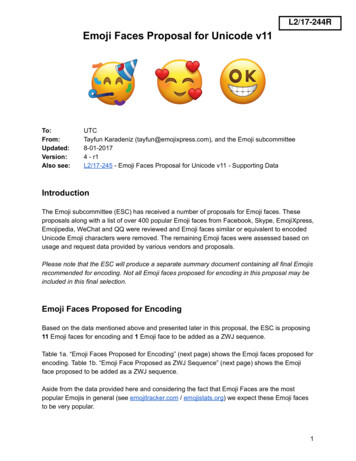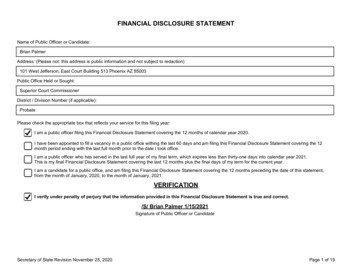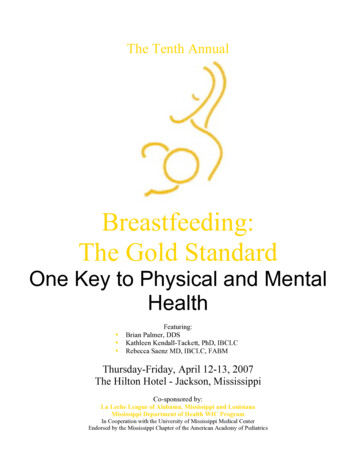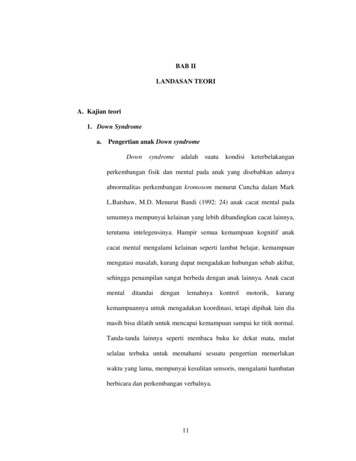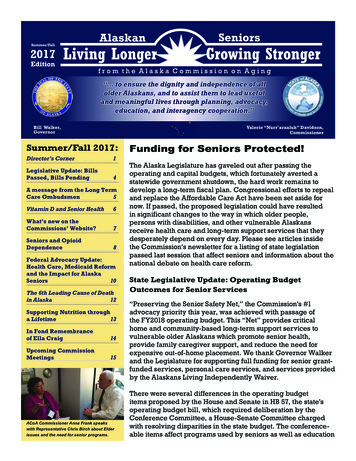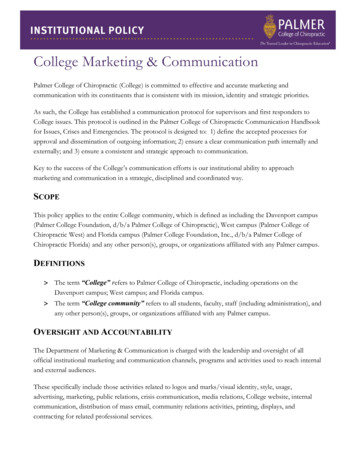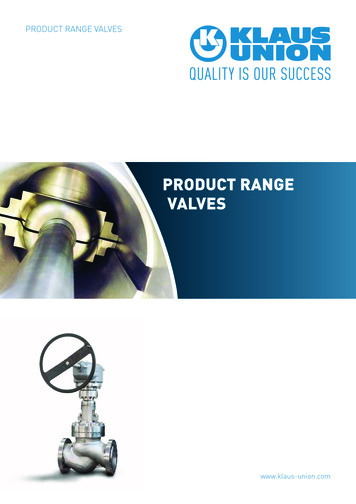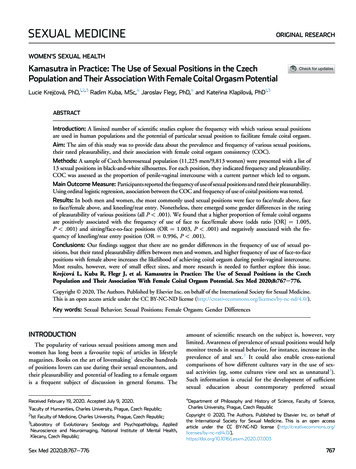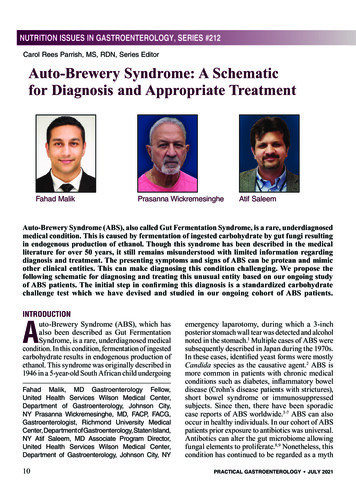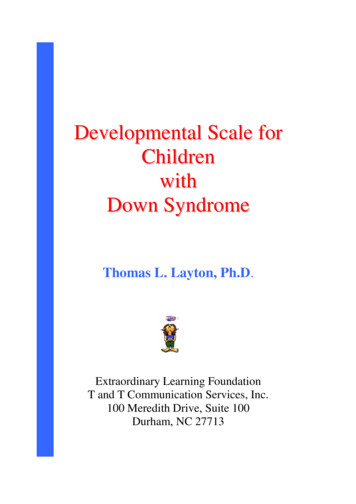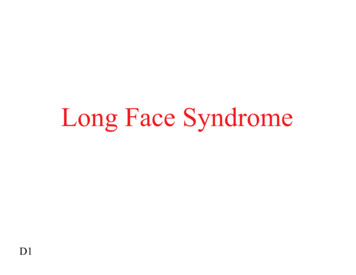
Transcription
Long Face SyndromeD1
Facial form and risk for sleep apnea Craniofacial features can be a strongindicator of risk for the development ofobstructive sleep apnea syndrome (OSAS).Guilleminault C, Parinen M, Lollman K, Powell N, Stoohs R. Familialaggregates in obstructive sleep apnea syndrome, Chest 1995, 107:1545-1551.D2
C41D3Test yourself. Hold your nose and see what happens.
D4Massive tonsils can obstruct the airway (Age 12).
D5Oropharynx of previous child after tonsils removed.
TonsilsD6Compromised oropharynx (age 7).
TonsilsD7Compromised oropharynx (age 27).
TonsilsD8Compromised oropharynx (age 30).
Long face syndrome (age 14).D9
Oropharynx of 14 year old with long face syndrome.D10
D11Anterior occlusion. Note spaces between teeth and rednessaround some of his front teeth. (Result of mouth breathing).
D12Note his tongue thrust (arrows).
Note long face. Alsonote shape of mouth similar to excessivethumb sucker.D13
D14Significant malocclusion on previous patient.
D15Thrust that caused the spacing and malocclusion.
Adult with sleep apnea.Also has long face.D16
D17Previous patient - also has large tongue.
D18Compromised oropharynx and batteredthroat (redness) from snoring.
Typical forward angulationof head of a person withLong Face Syndrome.Forward angulation of thehead makes it easier tobreathe - ie - like in CPR.Many times also haspointed prominence ofnose.D19
Long Face Syndrome Maintenance of the airway is closely related tocraniocervical posture. The larynx of the newborn is distinctive in itsform, proportion and structure. The tip of theepiglottis approximates the uvula. The muscles that maintain the airway areimportant elements in the motor mechanisms bywhich we achieve vertical posture.D20James Bosma. Functional anatomy of the upper airway duringdevelopment. Chapter 3, p47-84 in book, Respiratory Function of theUpper Airway. 1988, Marcel Decker.
Contributing factors to illness:D21 Not receiving mother’s immune system Decreased airway size due to:– edema, obstructions, genetics, etc. Day care contacts Hygiene practiced / contaminated pacifiers Environmental pollution Viral / bacterial outbreaks Stress Nutrition Economics
Most common infant allergy foods EggsPeanutsMilkSoyFishWheatAnnick Gaye, 1996 ILCA Conference, KC, MOD22
Principles involvedin airway collapse D23VacuumGravityVenturi principleBernoulli principle
VacuumA vacuum can create an inward collapseof the oral cavity, throat and airway.D24
GravityJaw and tongue areforward while awake.While asleep, musclesrelax and gravity can dropthe tongue back and blockoff the airway.D25
NASA ResearchConclusion of research in space:“This is the first direct demonstration that gravityplays a dominant role in the generation of apneas,hypopneas, and snoring in healthy subjects.”Elliott AR, Shea SA et al. Microgravity reduces sleep-disordered breathingin humans, 2001. Am J Respir Crit Care Med; Vol. 164:478-485.D26
Venturi PrincipleAir must pass through a small tube fasterthan through a large tube, if the volumeof air and time to pass through are equal.D27
D28
Bernoulli Principle Principle used in atomizers & carburetors. Causes an inward collapsing of a soft tube. Could cause an elongation of any stretchablematerial inside the tube.D29
D30Atomizer uses Bernoulli principle.
D31
D32
Elongated palate and uvula of a 14 year old with compromised airway.D33
Prehistoric skull with widepalate and large posterior nasalaperture. There is also goodwidth between the pterygoidplates. This allows for a widebeginning of the airway.D34
The wider the beginning ofthe airway, the less risk forcollapse of the airway.D35
Skull from the 1940sdemonstrating a high palateand narrow maxillary arch.Note small nasal aperture andless width between thepterygoid plates. This resultsin a narrow beginning of theairway - which creates agreater risk of airway collapse.D36
The narrower the beginning ofthe airway, the greater the risk forcollapse.For example, a narrow skinnystraw collapses a lot easier than awide straw when drinking a milkshake.D37
Path of Tensor palatini m. around Pterygoid hamulus. TensorD38arises from the canoe-shaped scaphoid fossa. (Grant’s Atlas)
D39 Rapid palatal expansion also expands the pterygoid plates.
Pterygoid hamulusWARNING-2D40 Path of Tensor palatini m. around the Pterygoid hamulus.
Dissection of adulthead from behind.UvulaEustachian tube (ET)Levator palatini m.Tensor palatini m.TongueD41
ETLevatorUvulaTensorTongueD42Zooming in on Tensor palatini, Levator palatini, and ET.Pointer is on Pterygoid hamulus.
In SummaryD43
Reasons for the collapse of the OralCavity and Airway Space Improper feeding - artificial bottles and nipples. Noxious habits - pacifiers, excessive digit sucking,lip sucking, blanket sucking, etc. Grossly enlarged tonsils, adenoids. Macroglossia and ankyloglossia. Facial-skeletal growth abnormalities. CNS dysfunctions affecting facial muscles. Drugs - sugar might be considered in this category.D44
“Prevention of SDB should be a public health priority A goodunderstanding of the underlying mechanisms associated withthe development of sleep-disordered breathing may allow earlydetection and, possibly, correction of anatomical risk factors.”“Current goals are to improve the early detection of SDB and todevelop a preventive strategy. Prevention requiresidentification of the genetic factors associated with SDB.”Claude Gaultier, Christian Guilleminault. Genetics, controlof breathing, and sleep-disordered breathing: a review.Sleep Medicine 2 (2001) 281-295.I agree there may be some genetic factors - but I stronglybelieve the main factors are: not breastfeeding, using bottlesand pacifiers, and exposing children to disease causingconditions and allergens.D45
Basic Principle:Overall healthis directly related to theEASE OF BREATHINGD46
ABC’s of Emergency Care Airway Breathing Circulation 4-6 minutes - Brain damage possible if not breathing. 6-10 minutes - Brain damage likely. Over 10 minutes - Irreversible brain damage certain.Community CPR - American Red CrossD47
Hypothesis:Prehistoric man did not have OSAIn prehistoric skulls you rarely find: High palates Narrow arches Overjets Non pathologic malocclusionsYou do find, however: Large posterior nasal apertures or choanae.D48
HypothesisBreastfeeding reduces the risk of OSA: By influencing ideal facial form and the properdevelopment of oral cavity and airway. By receiving nutrients and the mother’s immunesystem through the breastmilk the infant is moreresistant to infections. Infant’s sucking needs are better met on the breastthan on the pacifier - also impacts proper tongueaction during swallow. Less risk of obesity due to variable fat content ofmother’s breastmilk.D49
“Modern,non-breastfeeding nurturing,is having a negative impacton our health andevolutionary destiny.”Brian Palmer, D.D.S., 1998D50
Prevention is better than treatment!Early diagnosis and treatmentis the best prevention ofobstructive sleep apnea (OSA)and sleep disordered breathing(SDB).D51
My brother had a stroke in1995. One of the maincontributing factors was hisuntreated obstructive sleepapnea. He needed atracheotomy. He no longerhas the tracheotomy, but heis in a long term care facilityand will never get out.This one case of untreatedOSA has cost thousands ofdollars to the health careindustry.Do not let this happen to youor any of your loved ones!D52
My Dream:1. Have others accept my research asscientific and continue on with furtherresearch using this research for a basis.2. Challenge my research and try to provethat it is unscientific – I know it will beaccepted as scientific with time.3. Don’t let what happened to me happen toyour loved ones. Best to prevent.D53
There is no one ideal treatment for OSA. A tracheotomyis the only 100% cure for the condition. Nearly allcurrent treatments have unwanted side effects. The bestand cheapest form of treatment is prevention.Breastfeeding is the best way to prevent OSA.Therefore: Breastfeeding is the best andcheapest form of health care!Brian Palmer, D.D.S., 2001D54
“Knowledge is most meaningfulwhen shared with others.”Brian Palmer, DDSJune 4, 2004Please share this presentation with others.www.brianpalmerdds.comD55
Have a Great Day!Brian Palmer, DDSKansas City, MOJune 4, 2004
Brian Palmer, D.D.S., 1998 D50. Prevention is better than treatment! Early diagnosis and treatment is the best prevention of obstructive sleep apnea (OSA) . Brian Palmer, DDS Kansas City, MO June 4, 2004. Title: Microsoft PowerPoint - Section D [Read-Only] Author: Cathy Wacker
